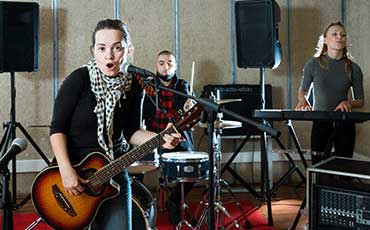Thinking of joining a rock Band? We have the testaments of many students who went through this rewarding journey. Know the reasons why many music aspirants prefer being a part of an explosive Music Band.
Let’s face it; we all are hesitant to showcase our skills in front of others. We fear disappointment and potential humiliation that might transpire when we falter during group practice.
The fear is felt more among music aspirants who seek to join a band or ensemble training. These young aspirants have to match the pitch, correctly follow the orchestration, and bear the burden of making their band outperform others. While the hesitation is understandable, band performance benefits the music aspirants in numerous ways. However, these benefits are often clouded by the seemingly insurmountable fear.
To accomplish an exceptional band and ensemble performance, strategic rehearsals are a must. These rehearsals allow students to get more actively and attentively involved in their practice. Also, the rehearsals educate music students the valuable lessons of working as a team. Instructors can engage students at different learning levels and nurture a conducive environment.
Here at Young Musician Music Institute, our professionals offer ensemble training sessions and classes that foster the performance skills in every student while refining their unique skill-set. Our rehearsals and courses are designed to help you develop music skills that you need to realize your musical ambitions.
Below we have discussed the techniques instructors need to incorporate and the rehearsal sessions that can ease the training session. So, let’s get practising.
Rehearsal Techniques
Instructors can incorporate varying rehearsal techniques to ensure active involvement and increased engagement from students. As a part of rehearsals, students can practice chamber music or the songs of rock bands and improve their vocal & instrument skills. Rock songs and chamber music allow children to practice outside their comfort zone and hone their skills.
A few of these proven rehearsal techniques are discussed below;
Traditional Rehearsal
Most of us are familiar with this type of rehearsal technique. In this setting, the conductor or instructor leads the group from the podium. In traditional rehearsal, seamless communication between the ensemble and conductor is of utmost importance.
Conductors and the ensembles convey musical meaning through gestures and expressions. In these rehearsals, the instructor should be open to offer their valuable feedback to students, guide them regarding their progress, and offer their suggestions to help students improve. A typical rubric checklist can be utilized as a self-assessment tool.
Drill Practice
Drill practices focus on perfecting short musical sections before moving to the next one. Instructors usually play a short phrase and allow students to repeat that part until it is perfect. Conductor or instructor directs the ensemble after every 3 to 5 seconds and then let the band play the short phrases repeatedly.
This technique is beneficial for practising one music concept at a time. Conductors can focus on the intonation, diction, and articulation of the ensemble and proceed when the ensemble has grasped that concept. Usually, the drill practice lasts for about 7 to 12 minutes, depending on the age group of the ensemble.
Walkabout Rehearsals
As the name suggests, this rehearsal requires conductors to move around the room during the session. Conductors orchestrate the ensemble from different locations of the room. Conductors may offer their help to different players in the ensemble. One key benefit of walkabout rehearsal is that it allows conductors to observe the performance and overall sound from different perspectives.
Conductors can signal the players to improve a particular section or ask the ensemble on how to improve specific phrases. Taking students input strengthens their musical judgement, elevates their engagement, and enhances ensemble rapport.
Non-conventional Rehearsals
Conductors can try out a different arrangement to lead the ensembles. Try arranging your students in small groups facing each other or position them in a square arrangement facing away from each other.
Incorporating different rehearsal techniques develop listening and musical judgement skills of the students.
Core Principles of Rehearsals
Before designing a rehearsal session, teachers and instructors should consider the following essential principles:
- Outline and design learning objective of every rehearsal. Have a clear idea of what you want to achieve from the rehearsal and how you can enable students to accomplish those objectives.
- Plan for activities and tasks that can improve student engagement. Come up with different scales, warm-ups and exercises that encourage active involvement from students. Note that all your exercises should pertain with the learning objective of the rehearsal.
- Keep the students involved throughout the training session. You can also offer rubric or checklist to the students and help them monitor their progress.
- Adjust the duration of the meeting according to the age group of your ensemble.
- Assess the understanding of the ensemble throughout the rehearsal. Evaluate the students based on their individual performance and section performance.
The Young Musician Music Institute offers a platform to the talented and young musicians to truly discover their musical potentials and direct those potentials to realize their musical ambitions.


